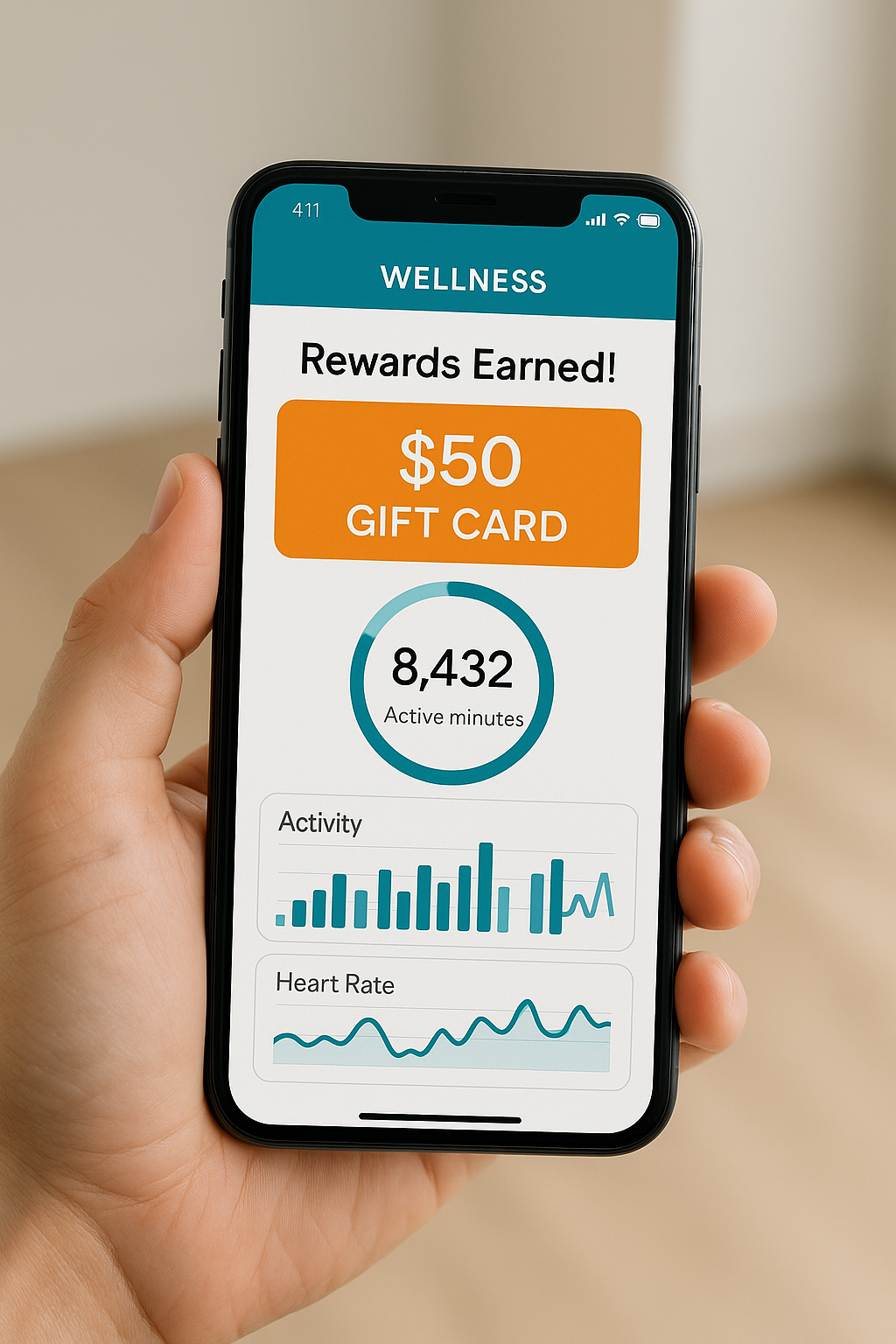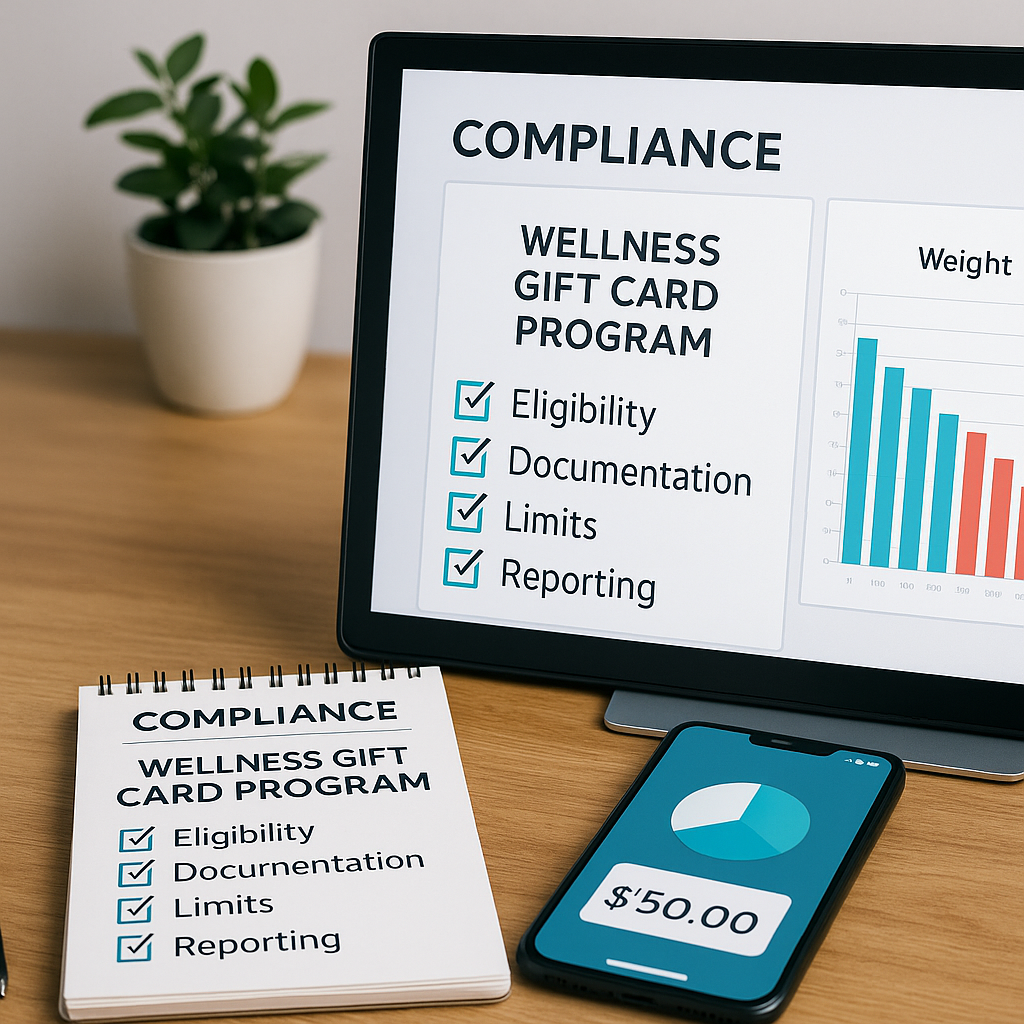Incentives for Behavior Change
Health and wellness initiatives often have strong intentions, but not consistently strong results. Why? Because getting people to change their behavior is hard, even when it’s in their best interest.
Motivation is the missing piece, whether it’s completing a biometric screening, enrolling in a chronic care program, or sticking with a wellness app for more than a few weeks. That’s where incentives come in.
Gift cards, predominantly prepaid or branded digital options, are a powerful tool to nudge people toward healthier behaviors. They offer immediate reinforcement, a sense of choice, and a tangible real-world benefit.
When designed and delivered correctly, incentives don’t just increase participation—they improve outcomes. They encourage action, drive consistency, and help you get more from your already invested in wellness programs.
The key? Ensure your rewards strategy is as thoughtful and compliant as the rest of your benefits offering.

CDC & IRF Insights on Wellness Rewards
You don’t have to take our word for it—the CDC and Incentive Research Foundation (IRF) emphasize the effectiveness of incentives in wellness engagement.
The CDC’s guidance on employer wellness programs acknowledges that financial and tangible incentives improve health outcomes, especially when tied to screenings, coaching, or preventative care. Meanwhile, the IRF highlights that non-cash rewards like gift cards are perceived as more rewarding and less transactional than cash or payroll bonuses.
This matters because the way your reward is perceived affects how often it works.
Participants who receive a gift card in response to completing a wellness activity are more likely to associate the action with success and repeat that behavior. When structured right, gift cards aren’t just a thank-you. They’re a reinforcement tool that can support long-term behavior change.
The science backs it. The outcomes prove it. The question becomes: how do you do it right?
Popular Reward Types: Prepaid, Merchant, Reloadable
When building a wellness incentive program, the type of reward you choose matters—more than many realize. It can determine how well your program performs and how much friction your participants or HR team experience along the way.
Here are the most common gift card formats used in health and wellness incentive programs:
Prepaid Gift Cards
These work like cash—but with controls. Prepaid Visa or Mastercard cards can be delivered digitally or physically and used almost anywhere. They’re ideal for programs where broad usability and recipient choice are essential. Plus, they feel like a true benefit and are perceived as higher in value than a check or payroll bonus.
Merchant Gift Cards
Want to tie rewards to lifestyle goals? Offer merchant-specific cards for retailers like Whole Foods, Fitbit, or Athleta. These are great options for curated experiences—wellness-oriented rewards that align with your program’s values.
Reloadable Cards
Reloadable cards are a powerful option for long-term engagement. You issue a single branded card and load additional incentives as users hit milestones. This approach builds momentum and keeps participants engaged over time.
Choosing the right mix depends on your audience, your goals, and—of course—your compliance needs.
HIPAA, IRS, and Wellness Compliance 101
Wellness rewards may seem simple on the surface, but compliance can’t be an afterthought if you’re operating in healthcare or offering incentives tied to personal health data. It has to be built in from the beginning.
Here are the three key areas to get right:
HIPAA (Health Insurance Portability and Accountability Act)
If your incentive program involves protected health information (PHI), you must ensure that any vendors handling this data are secure and compliant. That means choosing a gift card partner who can execute a Business Associate Agreement (BAA) and follow HIPAA protocols for encryption, data storage, and access.
IRS Reporting
The IRS treats gift cards as taxable income. For programs in the U.S., that means if someone receives $600+ in a calendar year, you may be required to issue a 1099. A well-designed platform can track totals per recipient, automate tax alerts, and provide clean reporting for your finance team.
Wellness Program Design & Non-Discrimination Rules
If you’re offering health-contingent incentives (e.g., quit smoking, reach a BMI threshold), you must provide a reasonable alternative standard per ACA rules. This ensures fairness for participants who may be unable to meet the original goal due to medical conditions or other factors.
At ADR, we’ve helped organizations navigate all of this. From reward design to automated compliance reporting, our systems are built to keep you aligned with the rules—without slowing your program down.
Case Study – Chronic Care + Rewards = Adherence Gains
A national healthcare provider we work with had a recurring challenge: their chronic care management participants were enrolling, but not staying engaged.
Despite excellent onboarding and support, adherence rates to monthly check-ins and remote monitoring goals fell off after 60 days. They needed a motivational and compliant solution, without adding more admin work.
We helped them launch a reloadable prepaid gift card program tied to key milestones:
- 30-, 60-, and 90-day adherence
- Biometric uploads
- Completing monthly education modules
Participants received their first digital card during onboarding, and then additional funds were added as they hit new goals.
The results?
- 38% increase in adherence past 90 days
- Reduction in staff hours spent on manual follow-up
- A seamless reward experience that participants could trust
Most importantly, the program met HIPAA standards and integrated with their existing care management platform, making it easy for clinical and compliance teams to align.
Wellness incentives aren’t just about participation. They’re about keeping people on track to better outcomes.
Delivery and Tracking Options
One of the most significant barriers to launching a gift card-based wellness incentive is logistics, especially if your team manages multiple programs across regions or with limited staff capacity.
That’s where digital gift card delivery shines.
With a platform like ADR’s, you can:
- Upload reward lists in bulk or automate them via API
- Deliver cards via email or SMS within seconds of a triggered event
- Customize the reward messaging and branding for a personalized experience
- Track who received what, when, and whether it was redeemed
You also get access to real-time dashboards that allow HR, program managers, or vendor partners to:
- Reissue expired or lost cards
- Flag duplicate participants
- Monitor reward redemptions and program performance
Need to offer cards in multiple currencies? Want to segment campaigns by business unit or client? No problem.
Everything is centralized and auditable, which is critical when managing compliance, reporting to clients, or allocating budgets across internal departments.
Incentives work best when they’re timely and easy to manage. The right platform makes that happen.

Budget Tips for Self-Funded Employers
If you’re a self-funded employer or manage wellness rewards on behalf of clients, you’re likely juggling two goals: engaging your people and protecting the bottom line.
Prepaid gift card programs can be surprisingly cost-effective when built with flexibility in mind.
Here are three ways to stretch your budget:
- Use Tiered Incentives: Start with small rewards for early-stage actions (e.g., $10 for a screening) and escalate for long-term engagement (e.g., $25 for completing a 90-day program).
- Implement Redemption Windows: Set expiration timelines on digital card links. Many providers allow you to reclaim unclaimed funds, helping you reduce waste.
- Offer Curated Choices: Let recipients choose from a range of merchant cards—but limit high-cost categories (like electronics or travel) to keep reward values predictable.
You can also align rewards with lower-cost but high-impact activities like group walking challenges, flu shot participation, or monthly wellness check-ins.
Wellness incentives don’t have to break the bank. The right design helps you drive behavior and control costs.
Check out our Guide to Prepaid Cards in Wellness
Whether you’re launching a new wellness program or trying to boost results from an existing one, gift card incentives can help you drive better participation, build long-term engagement, and keep your program in compliance.
But to do it right, you need more than just a list of vendors. You need a strategy, a system, and a partner that understands the nuances of HIPAA, IRS rules, and scalable reward delivery.
At All Digital Rewards, we’ve helped healthcare organizations, wellness tech companies, and self-funded employers design and run secure, branded, and results-driven incentive programs.
Ready to build yours?
Guide to Prepaid Cards in Wellness or schedule a consult with our team to explore your options.
Because when rewards are designed right, they don’t just comply—they change behavior.
🔗 Related Reading:
